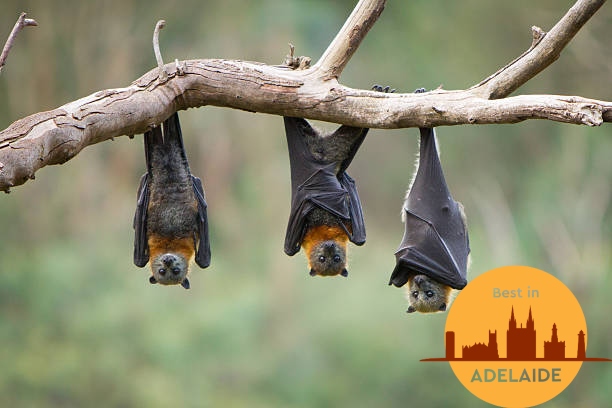
Botanic Bat Brigade: Learn About Flying Foxes in Adelaide
- What are the flying foxes in Adelaide’s botanic parks and gardens?
- Are flying foxes native to Adelaide’s botanic parks and gardens?
- How to differentiate the flying fox from other common bats in Adelaide?
- Are flying foxes in Adelaide’s botanic parks and gardens dangerous?
- What should I do if I see flying foxes in Adelaide’s botanic parks and gardens?
- Do flying foxes in Adelaide attack people?
- Are flying foxes pests in Adelaide’s botanic parks and gardens?
- What is the importance of flying foxes in Adelaide’s botanic parks and gardens?
A bunch of winged creatures of the night has taken up residence among Adelaide’s botanic parks and gardens’ serene greenery. Our botanic parks and gardens host flying foxes!
You may be curious about them and what they’re doing in our city, so we’ll be answering your burning questions below.
What are the flying foxes in Adelaide’s botanic parks and gardens?
The flying foxes in Adelaide’s botanic parks and gardens are gray-headed flying foxes (Pteropus poliocephalus) and are the largest bats native to Australia.
They have a distinctive appearance: a grey fur coat, a reddish-brown collar encircling their necks, and a notable grey head.
Gray-headed flying foxes normally have an impressive wingspan of approximately one meter, making them visually striking and well-adapted for their arboreal lifestyle.
Are flying foxes native to Adelaide’s botanic parks and gardens?
The gray-headed flying fox is not native to the Adelaide area. They migrated to South Australia due to limited food availability in the bats’ original range along the country’s eastern part.
Presently, gray-headed flying foxes are nationally threatened and listed as vulnerable under the Australian Environment Protection and Biodiversity Conservation Act.
The population of gray-headed flying foxes has been declining due to habitat loss, disturbance, and climate change impacts, making conservation efforts crucial for their survival.
How to differentiate the flying fox from other common bats in Adelaide?
In Adelaide, some examples of common bats that can be found alongside flying foxes are microbats such as the little forest bat (Vespadelus vulturnus) and Gould’s wattled bat (Chalinolobus gouldii),
However, unlike flying foxes, these microbats are much smaller.
Little forest bats and Gould’s wattled bats’ wingspan ranges from 20 to 35 cm, while grey-headed flying foxes’ wings range from 1 to 1.5 cm. The former also have rounder faces and smaller ears.
In addition, little forest bats and Gould’s wattled bats tend to have a faster and more erratic flight pattern compared to flying foxes.
Are flying foxes in Adelaide’s botanic parks and gardens dangerous?
Gray-headed flying foxes in Adelaide parks and gardens carry the risk of transmitting the Australian bat lyssavirus, a deadly disease related to rabies.
Lyssavirus can be transmitted through direct contact with the infected bat’s saliva or neural tissue, such as being bitten or scratched.
It’s advisable to avoid touching bats and to seek immediate medical assistance if you’ve had contact or exposure to bat blood or urine in the eyes, mouth, or nose.
Vaccines and post-infection treatments are available, but prevention through avoidance is the most straightforward approach.
What should I do if I see flying foxes in Adelaide’s botanic parks and gardens?
Due to the potential risk of lyssavirus, it’s important to remember that only individuals vaccinated against rabies should handle bats.
If you come across a flying fox or microbat in Adelaide’s botanic parks and gardens, it’s crucial not to touch it, even if it appears dead.
In the event of encountering an injured flying fox or microbat, it’s advisable to promptly contact local animal rescue organizations like Adelaide Bat Care or Fauna Rescue of South Australia, as they can provide the necessary assistance and guidance.
Below are the contact details of organizations that handle distressed flying foxes.
- The City of Adelaide Park Lands Ranger – 0407 394 662
- City of Adelaide’s Customer Center – 8203 7203
- Fauna Rescue – 8486 1139
- Bat Rescue SA – 0475 132 093
These organizations have the expertise to handle and care for injured bats while minimizing the risk of disease transmission. You may also reach out to nearby animal hospitals as an alternative.
Do flying foxes in Adelaide attack people?
It’s very rare for flying foxes to display aggressive behavior toward humans, and instances of actual attacks are exceptionally uncommon. These bats are generally shy and prefer to avoid human contact.
However, it’s important to respect their space and not approach or disturb them, as they are wild animals. Moreover, harming or harassing flying foxes is illegal, as they’re one of Adelaide’s protected wildlife.
Are flying foxes pests in Adelaide’s botanic parks and gardens?
Flying foxes aren’t considered pests in Adelaide’s botanic parks and gardens, as they have already coexisted with the local ecosystem since 2010, playing a vital role in pollination.
In addition, the flying fox population in Adelaide’s botanic parks and gardens is typically self-regulated. Factors such as the availability of food resources and suitable roosting sites naturally limit their population size, preventing overpopulation concerns.
What is the importance of flying foxes in Adelaide’s botanic parks and gardens?
Gray-headed flying foxes help maintain a healthy and balanced ecosystem in the parks and gardens through the following:
- Pollinating native plants
- Dispersing seeds for forest regeneration
- Supporting biodiversity through habitat provision
- Helping control insect populations, including agricultural pests





